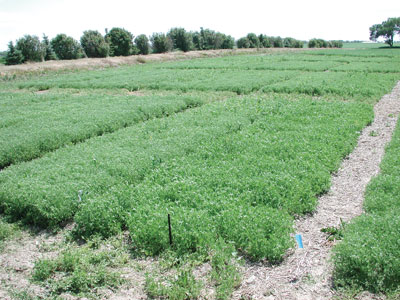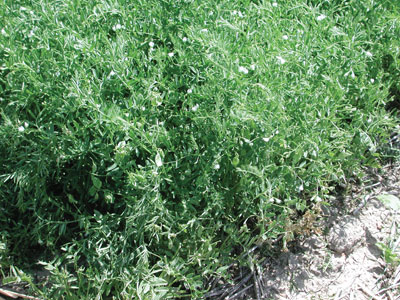
Features
Agronomy
Fertility and Nutrients
Winter pulses may be an option for Prairie farmers
Pulse crop breeding may be on the verge of another leap forward. Winter peas, lentils and fababeans could offer better yields, earlier marketing and more nitrogen fixation.
February 24, 2009 By Helen McMenamin
Pulse crop breeding may be on the verge of another leap forward. Winter peas, lentils and fababeans could offer better yields, earlier marketing and more nitrogen fixation. Winter peas and lentils have survived and yielded very well in a preliminary trial at Lethbridge, but their hardiness for other areas is uncertain.
 |
|
| Researchers are investigating the potential of winter pea. |
A new study will test winter peas, lentils and fababeans across Alberta to find whether they can overwinter successfully. If the crops survive the winter, the project will expand to look at other agronomic factors and quality traits to assess their potential in food and feed markets. Alberta Agriculture pulse specialist, Mark Olson, is spearheading the project, which includes sites at Lethbridge, Brooks, Lacombe and Edmonton. “Winter crops may be one of the brightest hopes for agriculture in this area,” says Olson. “They use early spring moisture and they’re growing when many farmers can’t get on the land to seed spring crops. They also flower earlier, avoiding the heat of summer that can shorten flowering and decrease yields of spring varieties. And with climate change, these advantages will be even greater. “Pulses love cool weather, so winter crops, with most of their growth in the cool part of the growing season, may be harvested earlier and have better quality than spring crops.”
Winter peas, such as Austrian winter or maple peas, have been grown for forage for many years, but the peas are small with dark brown or speckled coats that lower digestibility and palatability. Breeders in the Pacific Northwest crossed Austrian winter peas with spring types to develop their winter hardy varieties. The pea varieties include green and yellow types and the lentil is a red Turkish type developed for food. The fababean are a zero-tannin line from French pulse breeder,
Gérard Duc.
Olson’s project will look at the effects of seeding date and seeding rate on the three winter pulse crops. It is not certain that they will survive the winter at all locations, but he is optimistic. “We used to think winter wheat was only viable in the south,” he says. “Seeded into standing stubble should help it survive, or perhaps we can figure some way to improve survival. By seeding on various dates we’ll have crops at various growth stages at freeze-up. We hope to find the ideal seeding time and growth stage for winter survival.”
In a small trial at Lethbridge, winter peas have yielded close to 80 bushels and lentils 50 bushels, about 50 percent better than spring crops. Olson’s project will determine whether this sort of performance holds up in other locations. In one of the three years the crops have been grown at Lethbridge, yields were lower than for spring pulses, something that is also been seen in areas of Montana.
The plants freeze off in winter, but regrow from scale nodes below soil level. In southern Alberta plants can be at the four-leaf pair or four-node stage in early April. This early emergence and growth gives the crop an edge in competing with weeds, which are very small at that time. On the other hand, herbicides must be applied early, before the plants reach a stage that’s too advanced for safe spraying.
 |
|
| Winter pulse crops have yielded up to 50 percent higher.
|
Olson notes that the winter pulses have been brought to Alberta following trips well outside the Prairie region. An applied research association staffer saw the peas and lentils while on a tour to the Palouse region of Washington. Olson obtained the fababean seed through a meeting at a European pulse meeting. “We’ve been growing crop lines developed in Russia and other northern European countries for 100 years,” he says. “That region is still a likely source for crop germplasm suited to our environment.”The researchers working with Olson are looking at three different seeding dates and rates of the winter peas, lentils and fababeans. Soil nutrient levels, plant emergence in fall and the following spring, crop stage at freeze-up and soil temperatures will be monitored. They will also record flowering and maturity date, standability of each crop, nodulation and disease as well as yields.
Southern Applied Research Association (SARA) is developing winter pea and lentil agronomy for the Chinook zone, testing herbicide options and researching whether the crops can play a role in pea leaf weevil management.SARA is also working with North Dakota State University pulse breeder, Kevin McPhee, to assess winter hardiness in his lines. “We like to test new lines in stressful environments,” says McPhee. “In Lethbridge, I see some plots with ragged emergence due to winterkill. That’s ideal for us to assess winter-hardiness. We look at disease susceptibility in the mid-west where there’s more disease pressure than in the dry environment of Idaho and these Alberta plots will help in developing winter hardy varieties.”
Disease resistance is a major goal of breeding efforts for winter pulses. In early spring, cool moist conditions likely put the crop at higher risk for disease. Winter peas have a drawback in food markets, known as “ghosting,” in which the seed coat comes away from the hull. But it is slight and the breeders are working to improve their appearance.
In general, higher-yielding pulse crops leave a greater legacy of organic nitrogen for the following crop. If that holds for winter pulses, it would expand the crops’ benefits. Pulse crops would be harvested in good time for seeding winter wheat and to recharge soil moisture, and nitrogen fertilizer may not be needed for two years. Another winter crop would mean one more place where migratory birds could nest safely in spring, without being disturbed by seeding operations.